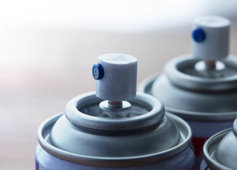Inhalants Drug Information

Inhalants are an odd substance to be addicted to as they are not, technically, drugs at all. They are chemical substances that create effects on a person that can be addictive. They can also be highly dangerous, causing brain damage and even death.
These products are available in almost any home or business and for that reason, they are very hard to keep away from young people who might use them. It is mostly the young who abuse these readily-available substances. In situations of disadvantage or homelessness, inhalant abuse is even more pronounced.
Inhalant Substances Being Abused
- Paint thinner
- Paint remover
- Degreaser
- Dry cleaning fluid
- Lighter fluid
- Gasoline
- Glue
- Correction fluid
- Felt-tip markers
- Spray paint
- Hair spray
- Computer cleaners (compressed air)
- Fabric protectors
- Vegetable oil sprayers
- Butane lighters
- Propane tanks
- Whipped cream aerosols
- Refrigerant gas
- Ether
- Nitrous Oxide
- Chloroform
- Amyl nitrate
- Rubber cement
- Shoe polish
As can be seen, most of these products are in very wide supply and can be purchased by anyone. Many states or cities restrict the sale of a few of these products to minors, but there are so many products on the list that there will always be others that are easy to get.
Abusing Inhalants

A person who intends to abuse one of these substances will probably use one of just a few methods: spraying it directly into the nose or mouth; placing a rag soaked with the substance in the mouth; spraying the substance into a bag and then inhaling from the bag; or snorting or sniffing the fumes directly from a container. It is normally a short-lasting high that must be repeated over and over, for as long as several hours.
The result of inhaling these substances is a drunken, euphoric condition. Speech slurs, a person lacks coordination and may be dizzy. Heavy users may experience hallucinations and delusions. Inhibitions drop away. Depending on which product was used, a person may have a headache after the intoxication fades away, along with confusion, nausea and vomiting.
Youth are Primary “Huffers”
While adults do abuse inhalants, it is mostly the young who look for these compounds to abuse. In 2011, nearly fifteen percent of eighth graders admitted that they had ever used inhalants. About eight percent of high school seniors said they had abused one of these substances. This adds up to more than two million youth.
The substances abused vary by age, with younger users abusing compounds that can found around the house, such as spray paint, glue or lighter fluid. Older children often abuse nitrous oxide or “whippets”—nitrous oxide canisters that are found inside a whipped cream container.
The average age of first use is 13 years. Unfortunately, young people usually do not have enough experience and knowledge to know about the damage that they are or could be doing to themselves by abusing inhalants.
The Dangers of Inhalants
A person abusing inhalants is risking harm such as this:
- Central nervous system or brain damage
- Bone marrow damage
- Hearing loss
- Spasms of arms or legs
- Damage to liver, heart or kidneys
- Death from heart failure
- Suffocation from the replacement of oxygen in the lungs with some other gas
Spotting Inhalant Abuse
Parents or other caretakers who wish to identify those abusing inhalants should watch for the following traces of this type of substance abuse:
- Chemical odors on breath, clothing or cloths around the house
- Paint remnants on face, clothes, bags or rags
- Empty solvent or paint containers
- Drunken, confused appearance
- Slurred speech
- Inability to focus
- Depression
- Nausea
- Vomiting
- Headaches
- No appetite
Just Like Other Drugs, Inhalants Can Cause Addiction
And just as with other drugs, recovering from inhalant abuse can require drug rehab. If a person can’t stop using these substances on his (or her) own, then it is necessary to get this person to an effective rehab that can help him turn his life around. There is, after all, a reason this person began abusing these substances. This reason must be remedied for sobriety to be stable. Some of these chemicals will be physically addictive as well.
The Narconon drug and alcohol rehabilitation program can help an inhalant abuser come all the way back to a sober, productive life. It takes helping each person detoxify the toxic substances that were inhaled, which is done on this program during the Narconon New Life Detoxification, one phase of the overall recovery program. It also takes helping a person bring back their interest and enthusiasm for survival, which takes place during the thorough life skills section of this program.
No matter what drug is being abused, the Narconon program has an innovative, drug-free approach to recovery.
Don’t let someone you care about suffer from addiction to inhalants or any drugs. Call Narconon today to locate a drug rehab program near you and learn how this can be the last drug rehab you or a loved one will ever need.
Resources:
 ®
®